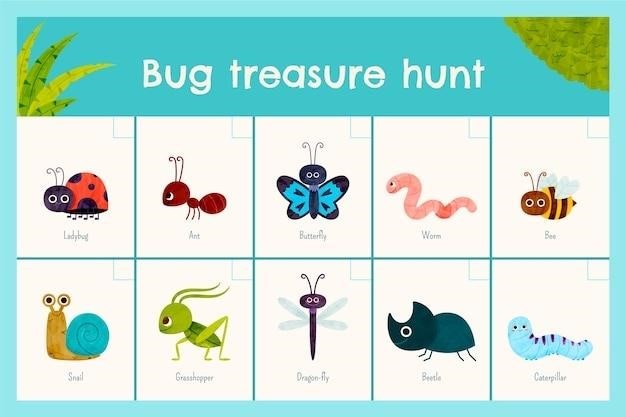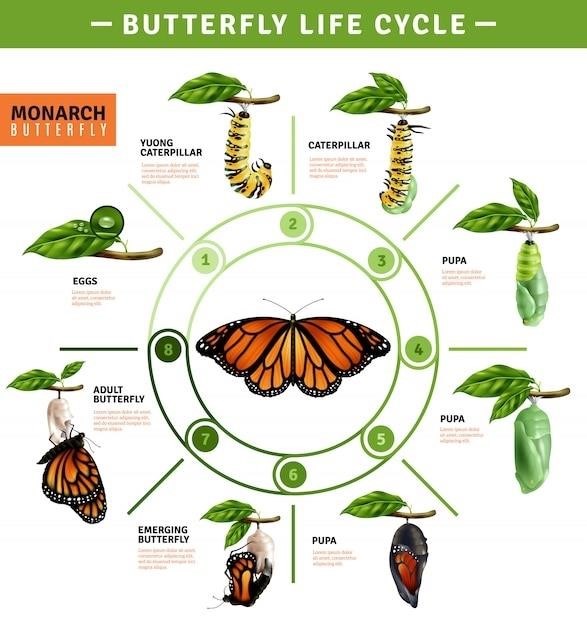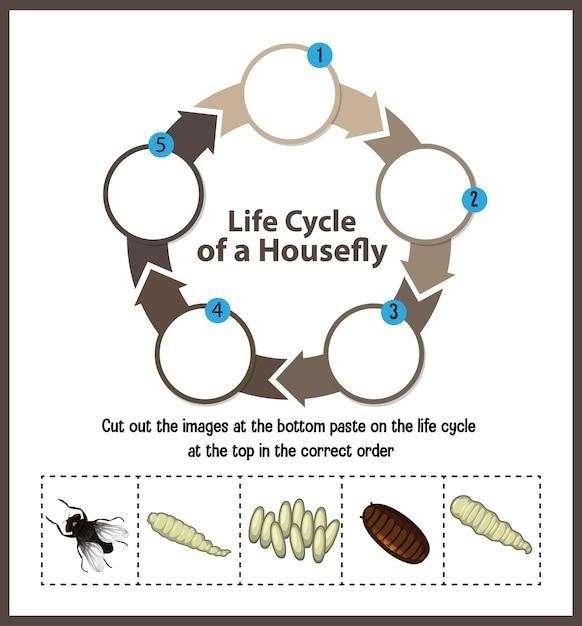caterpillar to butterfly kit instructions
- Published
- in Instructions
This comprehensive guide will walk you through the fascinating journey of raising your own butterflies from caterpillars. From selecting the right kit to releasing your beautiful winged creatures‚ this guide provides all the information you need for a successful and enjoyable butterfly experience.

Introduction
Witnessing the incredible transformation from caterpillar to butterfly is a captivating experience that sparks wonder and excitement in people of all ages. Butterfly kits offer a unique opportunity to bring this natural phenomenon right into your home‚ providing a hands-on learning experience about the butterfly life cycle. These kits are designed to be user-friendly‚ allowing you to observe the metamorphosis firsthand and create lasting memories with your family. Whether you’re a seasoned butterfly enthusiast or a curious beginner‚ a butterfly kit is a fantastic way to connect with nature and gain valuable insights into the incredible world of insects.
Choosing Your Butterfly Kit
When selecting a butterfly kit‚ consider the type of butterfly you’d like to raise. Painted Lady butterflies are a popular choice due to their vibrant colors and relatively easy care. Kits typically include a mesh enclosure‚ caterpillar food‚ and instructions. Pay attention to the number of caterpillars included in the kit. A kit with three caterpillars is a good starting point‚ as it provides a greater chance of successful metamorphosis. Look for kits that offer a guarantee‚ ensuring that a certain number of caterpillars will successfully transform into butterflies. It’s also essential to choose a reputable supplier with positive reviews to ensure the quality and health of the caterpillars.
Setting Up Your Habitat

The mesh enclosure provided in your kit serves as your butterflies’ home. Choose a location for the habitat that receives indirect sunlight‚ avoiding direct sunlight which can overheat the enclosure. Before introducing the caterpillars‚ it’s essential to prepare the habitat. Ensure the enclosure is clean and free of debris. Place the small plastic feeding dish and sponge in the center of the flower-shaped dish at the bottom of the habitat. This will be where the caterpillars will feed and pupate. Make sure the habitat is well-ventilated and secure to prevent escapes. Avoid placing the habitat in a location with drafts or excessive humidity.
Caterpillar Care
Once your caterpillars arrive‚ gently place the cup containing them inside the prepared habitat. The cup contains the necessary food for the caterpillars to grow. Keep the lid on the cup until the caterpillars have formed their chrysalises. Make sure the containers are standing upright at all times. Caterpillars are delicate creatures‚ so handle them with care. Avoid touching them directly‚ as their skin is sensitive. Observe the caterpillars closely as they eat and grow. They should be active and consuming the provided food. If you notice any signs of illness or unusual behavior‚ consult the troubleshooting section of this guide.
The Pupation Stage
After about a week or two‚ your caterpillars will be ready to pupate. They will stop eating and start to wander around the habitat‚ searching for a suitable place to form their chrysalises. They will usually hang upside down from a twig or the top of the habitat. Once they have found a spot‚ they will spin a silken pad and attach themselves to it. Then‚ they will shed their skin and transform into a chrysalis. This process can take several hours. During this time‚ it’s important to avoid disturbing the caterpillars. The chrysalis will initially be soft and green‚ but it will harden and change color over time. Keep the habitat clean and free of debris. Make sure it’s warm enough‚ as the caterpillars need a certain temperature to pupate properly. The pupation stage can last for several weeks‚ depending on the species of butterfly.
The Butterfly Emergence
The moment you’ve been waiting for has arrived! After a period of weeks‚ you’ll notice a change in the chrysalises. They will become darker and more translucent. This is a sign that the butterflies are about to emerge. The process can take several hours or even a day. You’ll see the butterfly’s wings slowly emerge from the chrysalis‚ and they’ll begin to pump fluids into their wings to help them expand. This is a fragile and delicate stage. The butterfly needs time to dry its wings and strengthen them before it can fly. Do not handle the butterfly during this time. Once the wings are fully dry and the butterfly is ready to fly‚ it will be time to release it into the wild. This is a beautiful and rewarding experience‚ and a testament to the amazing transformation that these creatures undergo.
Feeding Your Butterflies
Once your butterflies have emerged‚ it’s time to provide them with the nourishment they need. Butterflies primarily feed on nectar‚ which they obtain from flowers. You can provide them with a simple sugar solution to mimic nectar. Mix a teaspoon of sugar with a cup of water and place it in a shallow dish. Place the dish within your butterfly habitat‚ ensuring the butterflies can easily access it. You can also provide fresh fruits‚ like slices of oranges or bananas‚ as an additional food source. Remember to change the sugar solution and fruit slices every day to keep them fresh and prevent mold growth. It’s important to note that butterflies do not drink water directly. They use their proboscis‚ a long‚ straw-like tongue‚ to drink nectar from flowers. The sugar solution provides them with the necessary energy and nutrients to survive and thrive.
Releasing Your Butterflies
The moment you’ve been waiting for has arrived – it’s time to release your beautiful butterflies into the wild! Before you do‚ choose a suitable location. A garden with plenty of flowers is ideal‚ as it provides a natural food source and a safe haven for your butterflies. Avoid releasing them near busy roads or areas with pesticides. On a warm‚ sunny day‚ gently open the butterfly habitat and allow your butterflies to flutter out. They will instinctively fly towards flowers and begin exploring their new surroundings. As you watch them soar‚ remember that you’ve played a vital role in their life cycle‚ providing them with the care and nourishment they needed to transform from caterpillars into magnificent butterflies. This is a truly rewarding experience‚ and it’s a wonderful way to connect with nature and learn about the wonders of the natural world. Enjoy the beauty and freedom of your butterflies as they embark on their new adventure.
Troubleshooting
While raising butterflies is generally straightforward‚ there might be a few hiccups along the way. If your caterpillars aren’t eating‚ check the food source. It might be old or dried out. Replace it with fresh food if needed. If your caterpillars are lethargic or seem unwell‚ make sure the temperature and humidity are appropriate. A dry environment can dehydrate caterpillars‚ so ensure the habitat is sufficiently moist. If a caterpillar forms a chrysalis but doesn’t seem to be developing‚ it might be due to a lack of proper humidity. Try misting the habitat lightly to increase moisture levels. If you notice any mold or fungus growth in the habitat‚ it’s important to clean it thoroughly. A clean and healthy environment is essential for the well-being of your caterpillars. Remember‚ if you’re unsure about anything‚ it’s always best to consult the instructions provided with your butterfly kit or seek guidance from a knowledgeable source. With a little patience and care‚ you can successfully navigate any challenges and enjoy the fascinating transformation from caterpillar to butterfly.
Frequently Asked Questions
Here are some common questions about raising butterflies from caterpillars⁚
- How long does it take for caterpillars to turn into butterflies? The duration of the metamorphosis process varies depending on the butterfly species‚ but generally takes around 4 weeks.
- What do I do if a caterpillar dies? Unfortunately‚ not all caterpillars survive‚ and some might succumb to illness or other unforeseen circumstances. It is important to remember that even experienced butterfly raisers might encounter losses.
- Can I release the butterflies outside? It is generally recommended to release butterflies into a safe and suitable environment‚ such as a garden with plenty of flowers. It is important to ensure that the butterflies are released in a location where they can thrive and find suitable food sources.
- How can I make my butterfly habitat more attractive? Adding flowers or plants that butterflies are drawn to can enhance the experience for both you and the butterflies. Consider adding a small water source‚ such as a shallow dish with pebbles‚ for the butterflies to drink from.
- What if my butterflies don’t emerge? Sometimes‚ butterflies might not emerge from their chrysalis. This can be due to various reasons‚ such as a lack of humidity or a disturbance during the pupation stage. If a butterfly remains in its chrysalis for an extended period‚ it is best to consult the instructions provided with your butterfly kit or seek guidance from a knowledgeable source.
Safety Precautions
While raising butterflies is a rewarding experience‚ it’s crucial to prioritize safety for both yourself and your butterfly companions⁚
- Wash your hands thoroughly⁚ Before and after handling caterpillars‚ chrysalises‚ or butterflies‚ it’s vital to wash your hands thoroughly with soap and water. This helps prevent the spread of bacteria or parasites that could harm your butterflies or you.
- Avoid touching the caterpillars’ mouths⁚ Caterpillars are delicate creatures‚ and touching their mouths can cause stress or even injury. It’s best to observe them from a safe distance and allow them to feed and grow naturally.
- Keep the habitat clean and dry⁚ Maintain a clean and dry environment for your butterflies. This helps prevent the growth of mold or bacteria that could harm your butterflies. Regularly clean the habitat with a mild disinfectant solution and ensure good ventilation.
- Handle butterflies with care⁚ Butterflies are fragile‚ and their delicate wings can be easily damaged. If you need to handle a butterfly‚ gently support its body and avoid touching its wings. Allow the butterfly to land on your finger or hand and let it fly away naturally.
- Supervise children⁚ If children are involved in the butterfly raising process‚ ensure close adult supervision. Teach them the importance of handling the butterflies gently and respecting their delicate nature.
Raising butterflies from caterpillars is a captivating and educational experience‚ offering a unique opportunity to witness the wonders of nature firsthand. By following the instructions provided in this guide‚ you can create a nurturing environment for your butterflies‚ ensuring their healthy development and metamorphosis. As you observe the transformation from caterpillar to butterfly‚ you’ll gain a newfound appreciation for the intricate life cycle of these magnificent creatures. The release of your butterflies into the wild is a poignant moment‚ a testament to the beauty and fragility of nature. Remember to uphold the importance of butterfly conservation by creating butterfly-friendly habitats in your garden or community‚ providing a safe haven for these delicate creatures to thrive. Through careful observation and responsible care‚ you can contribute to the preservation of these vital pollinators and inspire others to embrace the magic of the butterfly life cycle.
